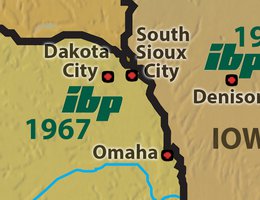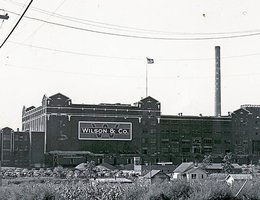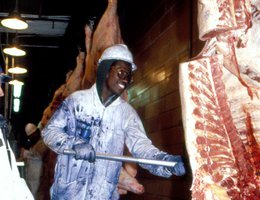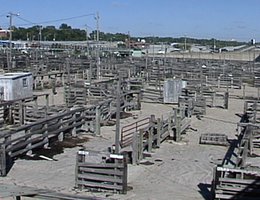

In 1961, a new operation, Iowa Beef Packers (soon known as IBP) opened. It was forty-five miles to the east and north of Omaha, in Denison, Iowa. IBP located in Denison to be close to the production of both corn and cattle. Its founders set out to completely rethink meatpacking.
Traditional packing houses were multi-story buildings where livestock were driven up a long ramp to the top floor. They would also slaughter different species in the same building, which required different departments. Then they moved the carcass from the killing room to the chiller and into a railcar.


Iowa Beef Packers, as its name suggests, slaughtered only beef. Its building was all on the ground level and completely refrigerated. By refrigerating from the beginning, they were able to prevent shrinkage due to dehydration. They also created a true disassembly line where each person had one certain task in the butchering process.
This method greatly reduced the skill level that a meat processor needed, opening up jobs to a larger number of workers. In Denison, they found an eager work force, mostly people with experience in agriculture. Importantly, this labor force was not organized into a union. A non-unionized, lower-skilled workforce meant the company could pay lower wages. All of these factors combined to give IBP a strong market advantage.
They also saved money by going directly to the rancher or farmer to buy cattle. This took the stockyards out of the deals. And with large trucks, they transported their cattle straight from the feedlot to the processing plant which saved even more money.

IBP also changed the industry by developing boxed beef. Transporting carcasses to butchers required more time, space, and money. It meant that the slaughterhouse shipped a lot of waste material, and carcasses did not fit easily into the rectangular spaces of refrigerated trucks and rail cars. By cutting the carcasses into smaller pieces that fit nicely into boxes, they were able to pack much more beef into a truck. This greatly reduced the cost for transportation. Because they were doing more of the processing at their plant, the beef required less skilled labor at the meat counter.
In 1967, IBP opened a new, highly automated and immense plant at Dakota City, Nebraska, a small town just across the Missouri River from Sioux City, Iowa, another major meat-producing city. This became their flagship plant and headquarters.
IBP’s innovations seriously threatened traditional meatpacking jobs, and national unions knew that. Soon, the Dakota City plant became the location of dramatic, sometimes violent, strikes.

By 1973, the busy stockyards and packing plants of twenty years earlier were almost gone. Nebraska was still a beef state, but the way beef was fed, slaughtered, and sold had completely changed in just a quarter of a century.